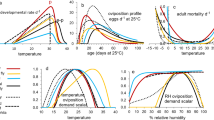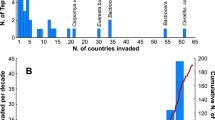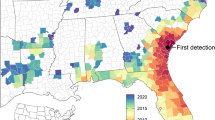Abstract
Agricultural ecosystems are being increasingly exposed to the interactive effects of biological invasions, climate fluctuation, and human actions, with increasing temperatures and intense transportations expected to lead to the aggravation of alien species invasions. We thus assessed this expectation for a global invasive pest, the oriental fruit fly (Bactrocera dorsalis), by determining whether climate variation and transportation activities affect invasion dynamics of this epidemic in California. We found that both temperature fluctuation (growing degree days) and transportation activities (passenger volume) have significant effects on interannual fluctuations of the oriental fruit fly detection events and infested areas. In addition, both detection events and infested areas of the oriental fruit fly were significantly higher in warmer years, while annual precipitation had no significant effects on invasion dynamics of the oriental fruit fly. The growing degree days contributed much more to the invasion dynamics than passenger volume, while passenger volume facilitated an increase in infested area more than growing degree days. Then, we introduced a conceptual framework of synergy model of climate change and transportation activities to illustrate invasion dynamics of the oriental fruit fly, revealing both the invasion dynamics in a fixed cell according to growing degree days and the spatial transmission of invasive alien species by passenger volume. Our findings shed light on the spatial invasion dynamics of alien species, with potential implications for understanding the trajectories of biological invasions under changing future climates and transportation activities.





Similar content being viewed by others
References
Andow DA, Kiritani K (2016) Density-dependent population regulation detected in short time series of saproxylic beetles. Popul Ecol 58:493–505. https://doi.org/10.1007/s10144-016-0558-x
Banks NC, Paini DR, Bayliss KL, Hodda M (2015) The role of global trade and transport network topology in the human-mediated dispersal of alien species. Ecol Lett 18:188–199. https://doi.org/10.1111/ele.12397
Bellard C, Thuiller W, Leroy B et al (2013) Will climate change promote future invasions? Global Change Biol 19:3740–3748. https://doi.org/10.1111/gcb.12344
Bruno JF, Carr LA, O'Connor MI (2015) Exploring the role of temperature in the ocean through metabolic scaling. Ecology 96:3126–3140. https://doi.org/10.1890/14-1954.1
Bullock JM, Bonte D, Pufal G et al (2018) Human-mediated dispersal and the rewiring of spatial networks. Trends Ecol Evol 33:958–970. https://doi.org/10.1016/j.tree.2018.09.008
Cai WJ, Borlace S, Lengaigne M et al (2014) Increasing frequency of extreme El Nino events due to greenhouse warming. Nat Clim Change 4:111–116. https://doi.org/10.1038/Nclimate2100
Clark NJ, Wells K, Lindberg O (2018) Unravelling changing interspecific interactions across environmental gradients using Markov random fields. Ecology 99:1277–1283. https://doi.org/10.1002/ecy.2221
Dale AG, Frank SD (2017) Warming and drought combine to increase pest insect fitness on urban trees. PLoS ONE 12:e0173844. https://doi.org/10.1371/journal.pone.0173844
De Villiers M, Hattingh V, Kriticos D et al (2016) The potential distribution of Bactrocera dorsalis: considering phenology and irrigation patterns. B Entomol Res 106:19–33. https://doi.org/10.1017/S0007485315000693
Douma JC, van der Werf W, Hemerik L et al (2017) Development of a pathway model to assess the exposure of European pine trees to pine wood nematode via the trade of wood. Ecol Appl 27:769–785. https://doi.org/10.1002/eap.1480
Dullinger I, Wessely J, Bossdorf O et al (2017) Climate change will increase the naturalization risk from garden plants in Europe. Global Ecol Biogeogr 26:43–53. https://doi.org/10.1111/geb.12512
Ekesi S, De Meyer M, Mohamed SA et al (2016) Taxonomy, ecology, and management of native and exotic fruit fly species in Africa. Annu Rev Entomol 61:219–238. https://doi.org/10.1146/annurev-ento-010715-023603
Fahey C, Angelini C, Flory SL (2018) Grass invasion and drought interact to alter the diversity and structure of native plant communities. Ecology 99:2692–2702. https://doi.org/10.1002/ecy.2536
Franić I, Prospero S, Hartmann M et al (2019) Are traded forest tree seeds a potential source of nonnative pests? Ecol Appl 29:e01971. https://doi.org/10.1002/eap.1971
Gallardo B, Clavero M, Sanchez MI, Vilà M (2016) Global ecological impacts of invasive species in aquatic ecosystems. Global Change Biol 22:151–163. https://doi.org/10.1111/gcb.13004
Gippet JMW, Liebhold AM, Fenn-Moltu G et al (2019) Human-mediated dispersal in insects. Curr Opin Insect Sci 35:1–7. https://doi.org/10.1016/j.cois.2019.07.005
Gobin J, Lester NP, Fox MG, Dunlop ES (2018) Ecological change alters the evolutionary response to harvest in a freshwater fish. Ecol Appl 28:2175–2186. https://doi.org/10.1002/eap.1805
Harris RMB, Kriticos DJ, Remenyi T, Bindoff N (2017) Unusual suspects in the usual places: a phylo-climatic framework to identify potential future invasive species. Biol Invasions 19:577–596. https://doi.org/10.1007/s10530-016-1334-8
Hausch S, Vamosi SM, Fox JW (2018) Effects of intraspecific phenotypic variation on species coexistence. Ecology 99:1453–1462. https://doi.org/10.1002/ecy.2346
Hulme PE (2009) Trade, transport and trouble: managing invasive species pathways in an era of globalization. J Appl Ecol 46:10–18. https://doi.org/10.1111/j.1365-2664.2008.01600.x
Hulme PE (2017) Climate change and biological invasions: evidence, expectations, and response options. Biol Rev 92:1297–1313. https://doi.org/10.1111/brv.12282
Janion-Scheepers C, Phillips L, Sgro CM et al (2018) Basal resistance enhances warming tolerance of alien over indigenous species across latitude. Proc Natl Acad Sci USA 115:145–150. https://doi.org/10.1073/pnas.1715598115
Jepsen JU, Hagen SB, Ims RA, Yoccoz NG (2008) Climate change and outbreaks of the geometrids Operophtera brumata and Epirrita autumnata in subarctic birch forest: evidence of a recent outbreak range expansion. J Anim Ecol 77:257–264. https://doi.org/10.1111/j.1365-2656.2007.01339.x
Karban R, Orrock JL (2017) A judgment and decision-making model for plant behavior. Ecology 99:1909–1919. https://doi.org/10.1002/ecy.2418
Kelly AE, Goulden ML (2008) Rapid shifts in plant distribution with recent climate change. Proc Natl Acad Sci USA 105:11823–11826. https://doi.org/10.1073/pnas.0802891105
Kolb TE, Fettig CJ, Ayres MP et al (2016) Observed and anticipated impacts of drought on forest insects and diseases in the United States. Forest Ecol Manag 380:321–334. https://doi.org/10.1016/j.foreco.2016.04.051
Lancaster LT (2016) Widespread range expansions shape latitudinal variation in insect thermal limits. Nat Clim Change 6:618. https://doi.org/10.1038/NCLIMATE2945
Leishman MR, Gallagher RV (2015) Will there be a shift to alien-dominated vegetation assemblages under climate change? Divers Distrib 21:848–852. https://doi.org/10.1111/ddi.12338
Liebhold AM, Berec L, Brockerhoff EG et al (2016) Eradication of invading insect populations: from concepts to applications. Annu Rev Entomol 61:335–352. https://doi.org/10.1146/annurev-ento-010715-023809
Liu YJ, Oduor AMO, Zhang Z et al (2017) Do invasive alien plants benefit more from global environmental change than native plants? Global Change Biol 23:3363–3370. https://doi.org/10.1111/gcb.13579
Lovett GM, Weiss M, Liebhold AM et al (2016) Nonnative forest insects and pathogens in the United States: impacts and policy options. Ecol Appl 26:1437–1455. https://doi.org/10.1890/15-1176
Lu XM, Siemann E, Shao X et al (2013) Climate warming affects biological invasions by shifting interactions of plants and herbivores. Global Change Biol 19:2339–2347. https://doi.org/10.1111/gcb.12244
Lutscher F, Musgrave JA (2017) Behavioral responses to resource heterogeneity can accelerate biological invasions. Ecology 98:1229–1238. https://doi.org/10.1002/ecy.1773
Magozzi S, Calosi P (2015) Integrating metabolic performance, thermal tolerance, and plasticity enables for more accurate predictions on species vulnerability to acute and chronic effects of global warming. Global Change Biol 21:181–194. https://doi.org/10.1111/gcb.12695
McClelland GTW, Altwegg R, van Aarde RJ et al (2018) Climate change leads to increasing population density and impacts of a key island invader. Ecol Appl 28:212–224. https://doi.org/10.1002/eap.1642
McDowell NG, Michaletz ST, Bennett KE et al (2018) Predicting chronic climate-driven disturbances and their mitigation. Trends Ecol Evol 33:15–27. https://doi.org/10.1016/j.tree.2017.10.002
Miller AE, Wilson TL, Sherriff RL, Walton J (2017) Warming drives a front of white spruce establishment near western treeline, Alaska. Global Change Biol 23:5509–5522. https://doi.org/10.1111/gcb.13814
Moran EV, Hartig F, Bell DM (2016) Intraspecific trait variation across scales: implications for understanding global change responses. Global Change Biol 22:137–150. https://doi.org/10.1111/gcb.13000
Morey AC, Venette RC, Santacruz ECN et al (2016) Host-mediated shift in the cold tolerance of an invasive insect. Ecol Evol 6:8267–8275. https://doi.org/10.1002/ece3.2564
Mutamiswa R, Chidawanyika F, Nyamukondiwa C (2018) Superior basal and plastic thermal responses to environmental heterogeneity in invasive exotic stemborer Chilo partellus Swinhoe over indigenous Busseola fusca (Fuller) and Sesamia calamistis Hampson. Physiol Entomol 43:108–119. https://doi.org/10.1111/phen.12235
Neumann M, Mues V, Moreno A et al (2017) Climate variability drives recent tree mortality in Europe. Global Change Biol 23:4788–4797. https://doi.org/10.1111/gcb.13724
O’Loughlin LS, Green PT (2016) Habitat augmentation drives secondary invasion: an experimental approach to determine the mechanism of invasion success. Ecology 97:2458–2469. https://doi.org/10.1002/ecy.1473
Pecl GT, Araujo MB, Bell JD et al (2017) Biodiversity redistribution under climate change: Impacts on ecosystems and human well-being. Science 355:1389–1392. https://doi.org/10.1126/science.aai9214
Petitpierre B, McDougall K, Seipel T et al (2016) Will climate change increase the risk of plant invasions into mountains? Ecol Appl 26:530–544. https://doi.org/10.1890/14-1871
R Development Core Team (2017) R: A language and environment for statistical computing. R Foundation for Statistical Computing, Vienna, Austria
Rafajlovic M, Kleinhans D, Gulliksson C et al (2017) Neutral processes forming large clones during colonization of new areas. J Evol Biol 30:1544–1560. https://doi.org/10.1111/jeb.13124
Richardson DM, Rejmanek M (2011) Trees and shrubs as invasive alien species—a global review. Divers Distrib 17:788–809. https://doi.org/10.1111/j.1472-4642.2011.00782.x
Schweiger O, Biesmeijer JC, Bommarco R et al (2010) Multiple stressors on biotic interactions: how climate change and alien species interact to affect pollination. Biol Rev 85:777–795. https://doi.org/10.1111/j.1469-185X.2010.00125.x
Seebens H, Essl F, Dawson W et al (2015) Global trade will accelerate plant invasions in emerging economies under climate change. Global Change Biol 21:4128–4140. https://doi.org/10.1111/gcb.13021
Steiner LF (1952) Methyl eugenol as an attractant for oriental fruit fly. J Econ Entomol 45:241–248. https://doi.org/10.1093/jee/45.2.241
Thomas SM, Simmons GS, Daugherty MP (2017) Spatiotemporal distribution of an invasive insect in an urban landscape: introduction, establishment and impact. Landscape Ecol 32:2041–2057. https://doi.org/10.1007/s10980-017-0565-0
Tilman D (2004) Niche tradeoffs, neutrality, and community structure: A stochastic theory of resource competition, invasion, and community assembly. Proc Natl Acad Sci USA 101:10854–10861. https://doi.org/10.1073/pnas.0403458101
Tingley R, Garcia-Diaz P, Arantes CRR, Cassey P (2018) Integrating transport pressure data and species distribution models to estimate invasion risk for alien stowaways. Ecography 41:635–646. https://doi.org/10.1111/ecog.02841
Traveset A, Richardson DM (2014) Mutualistic interactions and biological invasions. Annu Rev Ecol Ecol 45:89–113. https://doi.org/10.1146/annurev-ecolsys-120213-091857
Tscharntke T, Karp DS, Chaplin-Kramer R et al (2016) When natural habitat fails to enhance biological pest control-five hypotheses. Biol Conserv 204:449–458. https://doi.org/10.1016/j.biocon.2016.10.001
Wallace JM (2014) Global warming and winter weather. Science 343:969–969. https://doi.org/10.1126/science.343.6172.729
Wavrek M, Heberling JM, Fei SL, Kalisz S (2017) Herbaceous invaders in temperate forests: a systematic review of their ecology and proposed mechanisms of invasion. Biol Invasions 19:3079–3097. https://doi.org/10.1007/s10530-017-1456-7
Wilson K, Grenfell BT, Shaw DJ (1996) Analysis of aggregated parasite distributions: a comparison of methods. Funct Ecol 10:592–601. https://doi.org/10.2307/2390169
Wilson CM, Schaeffer RN, Hickin ML et al (2018) Chronic impacts of invasive herbivores on a foundational forest species: a whole-tree perspective. Ecology 99:1783–1791. https://doi.org/10.1002/ecy.2384
Zeng Y, Reddy GVP, Li Z et al (2019) Global distribution and invasion pattern of oriental fruit fly, Bactrocera dorsalis (Diptera: Tephritidae). J Appl Entomol 143:165–176. https://doi.org/10.1111/jen.12582
Zhao Z, Hui C, Plant RE et al (2019a) Life table invasion models: Progression and species-specific partitioning. Ecology 100:e02682. https://doi.org/10.1002/ecy.2682
Zhao Z, Hui C, Plant RE et al (2019b) The failure of success: Cyclic recurrences of a globally invasive pest. Ecol Appl 30:e01991. https://doi.org/10.1002/eap.1991
Ziebarth NL, Abbott KC, Ives AR (2010) Weak population regulation in ecological time series. Ecol Lett 13:21–31. https://doi.org/10.1111/j.1461-0248.2009.01393.x
Acknowledgements
We thank the Editor-in-chief Dr. Michael Traugott and two anonymous reviewers for their constructive comments and advice on our manuscript. We also thank Mrs. Xiangfeng Shi, Hao Li, Jing Wei, and Yannan Wang for processing the oriental fruit fly detection data.
Funding
This research is partially supported by National Key R&D Program of China (2017YFD0200400) and the National Natural Science Foundation (No. 31770453).
Author information
Authors and Affiliations
Corresponding author
Ethics declarations
Conflict of interest
All authors declare no conflict of interest.
Ethical approval
This article does not contain any studies with human participants or animals performed by any of the authors.
Additional information
Communicated by N. Desneux.
Publisher's Note
Springer Nature remains neutral with regard to jurisdictional claims in published maps and institutional affiliations.
Electronic supplementary material
Below is the link to the electronic supplementary material.
Rights and permissions
About this article
Cite this article
Zhao, Z., Reddy, G.V.P., Chen, L. et al. The synergy between climate change and transportation activities drives the propagation of an invasive fruit fly. J Pest Sci 93, 615–625 (2020). https://doi.org/10.1007/s10340-019-01183-9
Received:
Revised:
Accepted:
Published:
Issue Date:
DOI: https://doi.org/10.1007/s10340-019-01183-9




